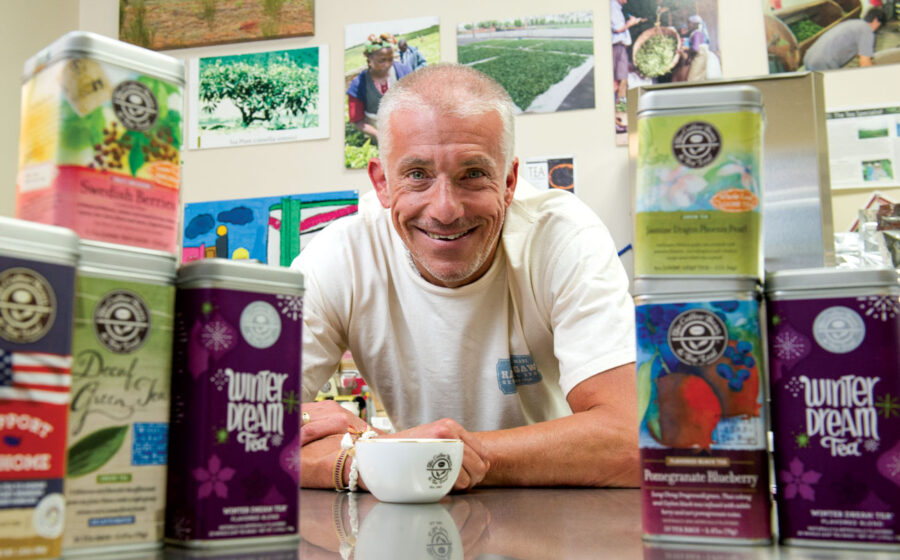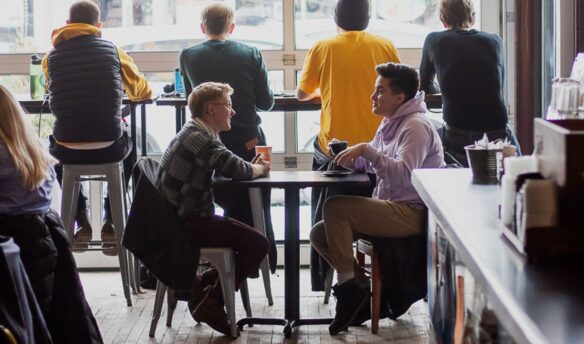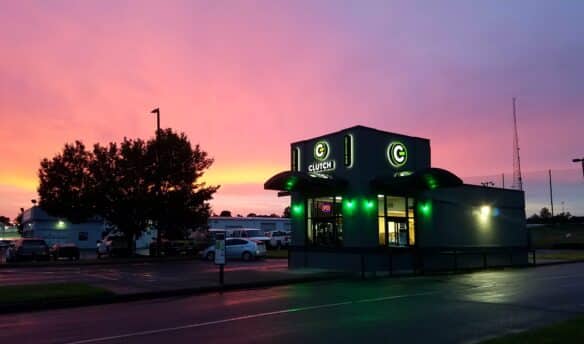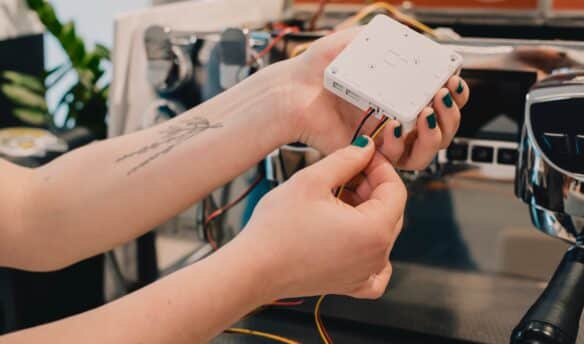[T]he phone connection comes in and out as the vehicle David De Candia rides in travels around the island of Hawaii. This was the best, really only, time to grab ninety minutes from the in-demand and on-the-move senior director of tea at the Coffee Bean & Tea Leaf. He had just helped judge the first major American tea competition, TOTUS, and would soon be headed home to California only to pack a bag and hop a flight to Sri Lanka, where he’s the ambassador of Ceylon tea for the Sri Lanka Tea Board.
De Candia decided to pack the TOTUS judging into his jet-lagged schedule because you only have one chance to discover the characteristics that future teas will be judged against. “I could be part of things at the genesis,” he says. Unlike judging teas from well-established locations, the TOTUS judges couldn’t apply strict parameters to the US-grown teas. “We couldn’t establish that yet, because if you did that prior and said, ‘Green has to be this, white has be this,’ then you would have to kick a lot of teas out,” De Candia says. “I said, ‘Let’s keep an open mind and score them on the various categories we judge them on.’ Then next year you take that information and build the criteria.”
Taking on something new has been the definition of De Candia’s tea career. He didn’t work anywhere near the industry until he was in his mid-thirties when he joined the Coffee Bean & Tea Leaf as its warehouse manager. It was six more years before he had tea in his title. Over eighteen years, he tasted his first high-end teas, acquired his first passport, visited his first estate, did his first blind cupping, developed the first in-house tea program for the Coffee Bean & Tea Leaf, and helped create Caring Cups, the company’s social responsibility project that, among many programs, cares for orphans in Sri Lanka, provides educational programs in Kenya, and supplies petroleum stoves to Darjeeling families who would otherwise use timber. Caring Cups is what De Candia is most proud of.
Before all of this, he was laid off by Halliburton.
So what happened after you were let go?
I looked in the paper and saw an ad for distribution manager for a small company eleven miles from my house. I told my wife, “Don’t worry. I’m going to take the job in the interim and I’ll look for something else.” I was hired on a ninety-day probationary period.
My position was distribution manager, it had nothing to do with tea. We really didn’t have a tea guy or a coffee guy. I just took it upon myself to pick up samples and start blending and creating. It was totally by surprise. It wasn’t a planned deal.
That was the element of your story that just does not make sense to me. You didn’t shift what you were doing, you wholly altered your career and changed what the company was doing.
I didn’t have anyone to lean on. I was struggling. Having to figure all of this out, on my own, without the answers just being there helped me get to where I am today.
Right, because it was family-owned they were open to someone taking the lead on one of their core products. At least I think so because they were like, “Yeah, go for it, see what you can do.” The idea that I took the position thinking it was more or less what I was doing prior—building warehouses, setting up distribution systems—it was a no brainer for me, so I had the time to look into tea.
Usually there’s a question that sets up this type of passion—what was it?
It was the fact that I knew nothing about it and that I had to rely on all these other elements that made me want to know more about it. That was really it. Every avenue I went to I would be told, “Well you don’t really need to know exactly where it comes from.” “Well, marketing is excited and they want to know a little more about this tea.” “It’s from China.” “Oh, well, China is a big place.” So in order for me to promote and grow the product, I needed to know more about it. And the only way to know more about it was to get more involved, and that meant going to source.
When did it go from “Hey, I want to find out more about this” to “I’m in love with this”?
I can tell you exactly when. It started a year after I got on board, and I was tasting a fancy Formosa oolong dragon from Taiwan. I would taste them and get flavors in them that for some reason or another I was able to describe. And I was like, “Holy moly.” It’s not like I’d never had tea before, but I’d never had tea like this. Where does this peach come from? How are these flavors coming from a straight cup of black tea. It just kept me wanting to do more tasting. The room I tasted in was a Vitamix blender repair room. Maybe eight-by-eight.
Did you have an interest in tea before this?
No. Dude, I didn’t even drink tea.
How in the world did you decide, “You know what, I’m going to do tea”? Was it that nobody told you, “Well you’re not a cupper, you don’t know the ins and outs of it.” Was there an element of naiveté?
Samples were showing up at the door everyday addressed to no one. So I just took it upon myself to start tasting. I found a pallet of cupping sets from Germany. No one knew what they were or how they ended up in the warehouse. So I started cupping things. We were getting our teas from Germany, already flavored, already blended. We had some space, so I got a cement mixer, I got a snow shovel, stainless steel floor, and paper booties and I started mixing the ingredients together and taking them upstairs to the owner. “Taste it, see what you think.” “Ah, it’s amazing.” “Guess what, now I don’t have to buy so-and-so’s blend, we can do our own.” Then the next step was finding out where this tea comes from.
I needed to go to source. But back then, seventeen years ago, how do I get ahold of anyone? I ran into a guy from India at the SCAA show, and he said, “If you want to come visit me, do so.” He said I needed a passport and a visa, of which I had neither. I had never been out of this country.
How did any of this even happen?
Yeah. I got my ticket and it was thirty-four hours door-to-door to Darjeeling. I knew the next step was to develop relationships with the growers, and at that point that was all I knew. I didn’t know that I could spend ten days cultivating the leaf that I want for the Coffee Bean & Tea Leaf. I didn’t know that then. I just knew the people and places where the tea comes from and that I can order the tea from them. But then what? Now that I’ve figured out how to get the tea, that lit the fire. I can create blends, but I have to figure out what teas I should use. Should it be a blend or a straight tea?
We had some space, so I got a cement mixer, I got a snow shovel, stainless steel floor, and paper booties and I started mixing
I didn’t have anyone to lean on. I was struggling. Having to figure all of this out, on my own, without the answers just being there helped me get to where I am today. If it had been right there, I wouldn’t have learned as much. I wouldn’t have made these trips. I could have sat there from eight to five, let the purchasing person buy a chest of blood orange, and kept running the plant. But when I got into tea, I kept saying, “I’ve got to know where this comes from, I don’t know why, but I have to get a handle on this thing.” I could have just missed it and this conversation would never have existed.
It seems that if you had known about everything you didn’t know, you’d have never gotten started. It would have been too massive an undertaking. You were wandering in the dark, illuminating every step.
I was supervising fifty people at the plant, I was the QA manager, production manager, production planner. As I got more into tea, I didn’t see it as a workload. I was trying to figure out how to make more time for it while still doing everyone’s payroll. The Coffee Bean & Tea Leaf’s idea then was store growth. When I was hired on, we had fifteen stores, now we have close to 1,300. Every weekend we were loading containers to ship out to open stores. It was everything from furniture to the nuts and bolts. I went to Israel to set up a coffee extract project. This was all during my journey into tea and I never, ever wavered.
If someone had told me what was what, I don’t think I would have learned it. I would have memorized it. If you do it your own way, on your own, all you need to do at some point is validate it. At some point you have to have some validation. You can’t call something what it isn’t just because you think that’s what it is. It has to have an identification within the industry. But once you do that and build the credibility, then I have the power to create leaves that don’t have a name. I create a lot of leaf in different countries where I don’t know what to call it. I don’t have a name. It’s not an OP, it’s not a BOP. It is what it is from where it comes from and I created it with the grower, and that’s the end of the story. You can only do that once you establish credibility either individually or as a company.
What was the switch that was flipped that turned you from the guy in the warehouse to, “no way, that guy started in the warehouse?”
About twelve years ago, we hired a VP of supply chain who came in and told me, “I’ve heard of you. And my priority is to hire a QC manager, hire a production manager, hire a production planner.” And I said, “Yeah, right.” He said, “Mark my words, I will do all of that and you will be able to do what you want to do. So, what do you want to do?” I’ll take the tea, I don’t want any of this other stuff.
The owners have never come into my lab, to this day, and said, “Man, is there anyway when you buy your teas you could dial down the costs?” That’s a testament. It’s easy to imagine someone coming in and saying, “Why are you buying vanilla bean from Madagascar, can’t you use an artificial flavor?”
The programs you’ve created through Caring Cup are a big drive for you now.
I have created eight social programs in eight different countries as a result of this. By far the social aspect of tea is leaps and bounds ahead of what we’ve talked about. What matters to me more is the estate workers and the communities within the tea-growing regions. That’s what matters more than any of it. And I learned it early on. It took thirty-four hours to get to Darjeeling, and I see these ladies plucking tea, and then I’m drinking that tea in the morning and what about them? You’re sitting in a nice bungalow with the estate owner, but how does this work, where do they go, what do they do? You can’t just ignore it. You can’t walk through an estate and pretend these people don’t exist. It hit me, and I kept asking more and more questions.
—Cory Eldridge is Fresh Cup’s editor.
















